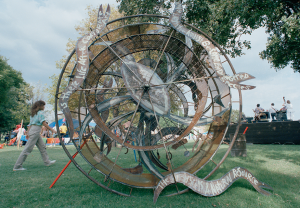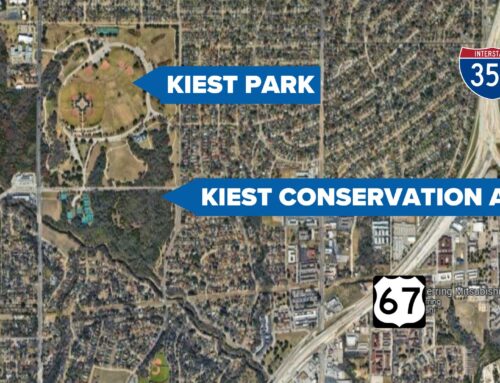The DallasSITES exhibit at the Dallas Museum of Art refers to them as the Oak Cliff Four, while the “Made in Oak Cliff” exhibit at Gray Matters Gallery references the Oak Cliff 5. Either way, their contributions to what became known as “Texas Funk” art are on display now through September.
At the DMA, Oak Cliff is one of six neighborhoods represented in the DallasSITES timelines spanning the last 50 years.
“This is Dallas’ contribution to this much larger community of contemporary art,” says Oak Cliff resident Gabriel Ritter, who co-curated the exhibit with research project coordinator Leigh Arnold. “In general, people are not familair with this history, and that’s the museum’s role — to educate.”
The work of the Oak Cliff Four — George T. Green, Jack Mims, Jim Roche and Robert “Daddy-O” Wade — in the early ’70s is highlighted within the timeline, and many more details not on view in the physical exhibit are in the DMA’s free e-catalogue of the exhibit (probably best viewed on a tablet). Mac Whitney is the fifth artist, but the DMA e-catalogue notes that “his loner mentality and strikingly different approach to his work separated him from the core group, who would become known as the Oak Cliff Four.”
Gray Matters’ history of the artists explains that they “worked in a loose community based in Oak Cliff, where cheap, spacious studios and living spaces could be found.” Mims was born and raised in the neighborhood, and “set up a studio in a home he inherited from his grandmother,” the DMA e-catalogue says. “Whitney established his studio in a two-story brick home next to a vacant lot near the Oak Farms Dairy and later moved to a ranch-style family home a few blocks from where [Lee Harvey] Oswald shot Officer [J.D.] Tippit. … Wade moved into a converted loft space on the corner of Beckley Avenue and Jefferson Boulevard. Green moved into the area around Bishop Avenue and Eighth Street, now known as the Bishop Arts District, and combined several empty apartments into one huge space.”

From the DMA’s DallasSITES e-catalogue: Greg Metz’s entry in the Oak Cliff Kinetic Sculpture Parade, September 21, 1985. Courtesy of the Dallas Morning News Archives
If you don’t know the art history of Oak Cliff since 1963, the e-catalogue is a fascinating read. At the physical exhibit, the Oak Cliff timeline is incredibly active in the ’70s, and then goes blank in the ’80s when “creative activity in Oak Cliff was relatively quiet.” Still, during that decade, “local artists again began revitalizing parts of the neighborhood. Greg Metz, Bill Haveron and Randy Twaddle moved into the vacant storefronts now known as the Bishop Arts District and jump-started the gentrification of the popular area. … By the mid- to late 1980s, developers had purchased many of the buildings Metz and his friends had renovated, sending them out to hunt for new space. Metz’s winning entry in the 1985 Oak Cliff Kinetic Sculpture parade [“Artist Wheel of Misfortune,” an oversized hamster wheel powered by the artist running inside it] was adorned with a sign that read, ‘Oak Cliff used to raise artists and chickens. Now they only raise the rent.’ ”
Cliffites who live here now know that artists (and chickens) are back. In fact, the Oak Cliff art scene is heavily represented in DallasSITES’ companion exhibit, “Available Space.” The timelines themselves reach into the 2000s, and “Available Space,” which highlights current contemporary art efforts such as Oak Cliff’s Oil & Cotton, “bring the project into the present day,” Ritter says. “You don’t want people to think it’s ossified and in the past. It’s ongoing.”
The DMA’s “Available Space” continues through Aug. 18, and “DallasSITES” through Sept. 15. Gray Matters Gallery’s “Made in Oak Cliff” also continues through Sept. 15. Admission is free to all exhibits.






